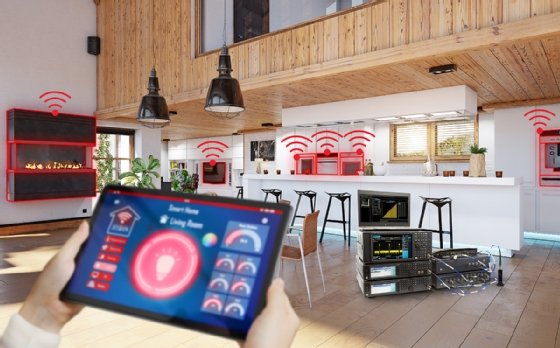
Natalia Merzlyakova - Fotolia
Regulatory compliance test for Wi-Fi 6E explained
Even though IoT devices found at work and home have gone through a long process of development, they still must undergo careful testing to ensure they stay in compliance.
Consumers rely on internet connectivity for many things, including connecting light fixtures, TVs and speakers to a home network. Health enthusiasts connect their wearables to the internet for data tracking. Doctors rely on the internet to obtain data from connected medical devices, such as pacemakers and pulse oximeters.
Whether it is to check emails on your smartphone or for mission-critical applications, evolving wireless connectivity has advanced the way we study, work and play. Wireless internet connectivity has evolved to become better and faster. However, how did we get to this point?
The evolution of Wi-Fi standards
A case in point is the family of 802.11 standards. Over the past 20 years, the IEEE 802.11 standard -- known more widely as Wi-Fi -- has evolved from 2 Mbps to gigabit-plus speeds, a thousandfold increase in throughput. The standard has advanced with protocols from 802.11a to 802.11n, 802.11ac and 802.11ax, covering Wi-Fi 6 and Wi-Fi 6E. The E in Wi-Fi 6E means extended. Wi-Fi 6E adds up to 1.2 GHz more Wi-Fi spectrum in the 6 GHz band with up to 2 Gbps speed, extremely low latency at less than 1 millisecond, and wider channels in the 80 MHz and 160 MHz bandwidths. Wi-Fi 6E supports higher capacity for more users and offers less interference because this frequency is not common to wireless household devices.
However, the Wi-Fi 6E spectrum is not vacant. Incumbent users include satellite and terrestrial microwave links. These incumbent services need protection from interference when the band is open for the new users. In the release announcement, the Federal Communications Commission (FCC) revealed new test requirements for Wi-Fi 6E devices. Some of the new requirements are different, such as antenna pattern limitations, but one complex new test will be like the European Telecommunications Standards Institute (ETSI) adaptivity test.

The regulatory compliance test for Wi-Fi 6E
The FCC defines seven device classes for indoor and outdoor installation. Indoor devices have a new requirement for channel sharing. The new requirement states that all devices must use a contention-based protocol (CBP), such as a "listen before talk" protocol that provides interference protection for incumbent services. The protocol is like ETSI's channel access engine. Like the adaptivity test, it simulates incumbent device signals but, in this case, only with a 10 MHz-wide additive white Gaussian noise signal. In terms of energy, this resembles other signals that the device must not interfere with but does not require demodulation of those signals, only the sensing of radio frequency energy.
However, a new Wi-Fi 6E device may occupy wider spectrum than the 10 MHz simulated signal. Therefore, testing must include all cases where device transmission overlaps the spectrum used by the incumbent signal, requiring multiple tests using different frequency configurations. In each case, the signal must be detected with at least 90% certainty if the interferer has a signal strength of ‑62 decibel-milliwatts or greater. Taken together, these requirements mean it is likely that many test repetitions will be necessary to comply with the regulation.
Other interesting Wi-Fi 6E test requirements
Although a CBP may be the most time-consuming test, there are other more common test requirements for new Wi-Fi 6E equipment. They include frequency stability, power control, bandwidth and unwanted emissions. Most of these are familiar to test engineers, with a few exceptions.
Since the incumbent users include satellite and terrestrial services, the Wi-Fi 6E equipment must not radiate signals at elevations above 30 degrees from the horizon. This radiated test varies depending on whether the antennas have fixed radiation patterns or are steerable.
Wi-Fi 6E also has different power limits for different classes of equipment. Therefore, a device that can connect to both low-power and full-power access points must adjust its power level to match the limitations imposed by the type of AP to which it attaches.
The future of regulatory compliance testing
These new, more complicated regulatory compliance tests have significantly increased the complexity of the test process. New tests, such as dynamic frequency selection, adaptivity and CBP, require the collection of large volumes of data at high speed and precise timing of device-under-test behavior. Future regulatory compliance test systems must be able to simplify pre-compliance testing and post-test analysis. The solution must be able to collect large volumes of data, which can be a time-consuming process, and analyze the data sets before generating informative reports. Another feature that lab managers and test engineers are looking out for is software automation. It not only helps shorten overall test time, but ensures efficient resource planning.
About the author
Janet Ooi is a lead in Keysight IoT Industry and Solutions Marketing. She graduated from Multimedia University in 2003 in business engineering electronics with honors majoring in telecommunications. She worked at Intel as a process and equipment engineer for five years before joining Agilent Technologies -- now known as Keysight Technologies -- in 2008 as a product marketing engineer. Since then, Ooi has also taken on product management, business development and market analyst roles.






